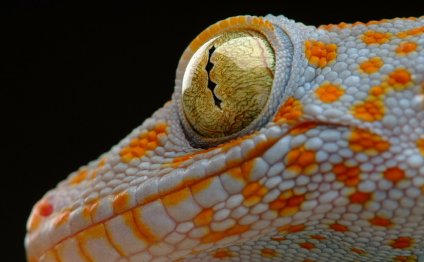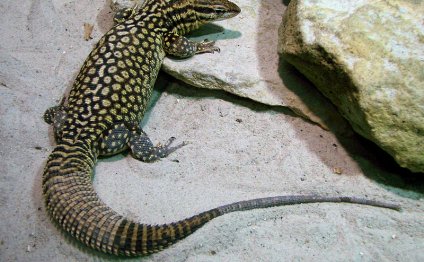
Venomous Snake for sale
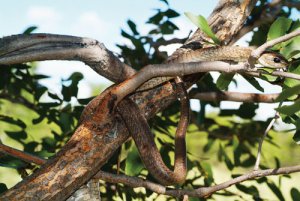 By Paul Donovan
By Paul Donovan
The boomslang is one of Africa's most venomous snakes.
Photo by William Warby/Wikipedia
Boomslang (Dispholidus typus)
Of all the venomous snakes offered for sale, one could not describe the boomslang (Dispholidus typus) as being common. The majority of individuals on the market are more likely to be wild-caught imports than captive bred. If you are after one of these snakes, you can find them at reptile stores that trade in venomous snakes, at expos or on the Internet. Expect to pay around $100 to $130.
Boomslang Legal Issues
Depending on where you live, before you can keep a venomous snake, it may be necessary to be in possession of a venomous snake licence. As a responsible snakekeeper, it is imperative that we comply fully with this legislation. Also, one should have a sound knowledge of keeping a range of non-venomous snakes before travelling down the venomous route. Proper procedures should also be set in place should you sustain a bite. All precautions should be taken to prevent a snake from escaping. A harmless snake escaping is bad news; a venomous snake escaping is irresponsible and exposes people to undue risk.
Photo credit: Paul Donovan
The arboreal boomslang can frequently be found in isolated trees within open clearings.
Boomslang Size
An adult boomslang reaches between 3 to 5 feet in length. In exceptional cases, it may reach more than 6 1/2 feet in some areas of its distribution.
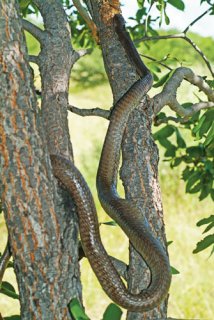 Boomslang Life Span
Boomslang Life Span
Properly kept, a boomslang can live 15-plus years.
Boomslang Housing
As an arboreal snake, a vivarium with good height is important. Boomslangs can be stressed if they do not have the ability to climb, and they should not be kept in off-the-shelf aquariums. A pair could comfortably be housed in a custom cage measuring 6 1/2 feet tall, 5 feet wide and 5 feet long. These are fast-moving snakes. To avoid escapes, have only a small access door for routine maintenance and feeding. The cage should also have some sort of trap box installed, so that the snake can be safely isolated when major husbandry work is required. Make sure the enclosure is secure and has a lock.
The boomslang averages between 3 and 5 feet, but in exceptional cases in some parts of its range, it may exceed six feet.
Boomslang Lighting and Temperature
Provide a daytime temperature of 75 to 85 degrees Fahrenheit, dropping to 65 to 68 degrees at night. It is important that humidity is kept low, as these are not wet-loving snakes. If kept in adversely wet conditions, respiratory problems can arise. This can usually be alleviated by fitting ventilation grills in the sidewalls of the cage. A metal grill roof will also be beneficial, as all electrical equipment can be suspended above this. By doing this you reduce the need to open the cage to replace electrical elements as and when they fail.
Boomslang Substrate and Accessories
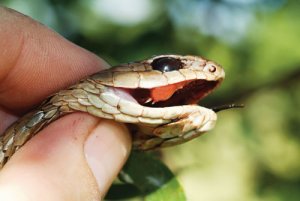 The enclosure should be furnished with numerous branches and robust foliage. Most of the snakes time will be spent within the branches, so the vivarium flooring can be any material that suits your preference - newspaper, bark chips, soil/peat etc. I used the latter because my vivarium was heavily planted with climbing ivy, a cheese plant and a rubber plant.
The enclosure should be furnished with numerous branches and robust foliage. Most of the snakes time will be spent within the branches, so the vivarium flooring can be any material that suits your preference - newspaper, bark chips, soil/peat etc. I used the latter because my vivarium was heavily planted with climbing ivy, a cheese plant and a rubber plant.
The boomslang is a rear fanged snake.
Boomslang Diet and Feeding
Boomslangs are active snakes, with a high metabolic rate. They should be fed at least once a week to maintain them in peak condition. In the wild, their staples diet are chameleons -in Botswana this is the flap-necked chameleon (Chamaeleo dilepis) -and birds. For my captives, I feed day-old chicks. However, I did encounter problems with the state of the chicks. If these were freshly thawed and wet, the snakes would not feed on them. They had to be dry and fluffy. Scent-marked mice would also be taken. Depending on the size of snake and the food, feed two food items per sitting; however, adjust this accordingly to the health of the snake. If it looks thin, increase; if it looks fat, decrease.
Boomslang Water and Humidity
A water bowl should always be provided for drinking, but some individuals may prefer to "drink" water from the leaves of plants. For this reason, the cage should be lightly misted every other day.
Boomslang Handling and Temperament
Boomslangs are not your average snake, and they should be treated as a dangerous, venomous species. When the need arises to move them from the enclosure for whatever reason, this should be done with the aid of a trap box.
Boomslang Breeding
Breeding boomslangs in captivity seems to be a hit-or-miss affair, coupled with a bit of good luck thrown in. Most captive breeding tends to occur in wild-caught individuals, rather than reared captive-bred stock. Although I maintained a wild-caught pair for several years, they showed only a tentative interest in mating, and nothing transpired from any liaisons.
Prior to the breeding season, the sexes should be separated and kept at 40 to 42 degrees for approximately six weeks. During this time, spray them lightly once a day. When ready to introduce them, raise the temperature of the female's cage back to normal parameters and introduce the male. Following a gestation period of some 60 days, the female will lay between 10 and 25 leathery eggs. These will be laid in damp vegetation, so it is important to put a container of damp vermiculite or peat/sand mix in the cage. If the female cannot find a suitable substrate in which to lay her eggs, she will do so in the water bowl.
RELATED VIDEO

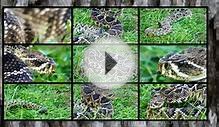
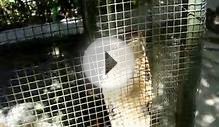
Share this Post
Related posts
Colorful lizard
A very large species of chameleon that is endemic to forests in eastern and northern Madagascar. They reach up to 68 cm (27…
Read MoreSmall pets Snake for sale
For ages 12 & up Can reach approximately 60 L Can live 30 years or more Carnivores Solitary Note: Pet availability…
Read More

